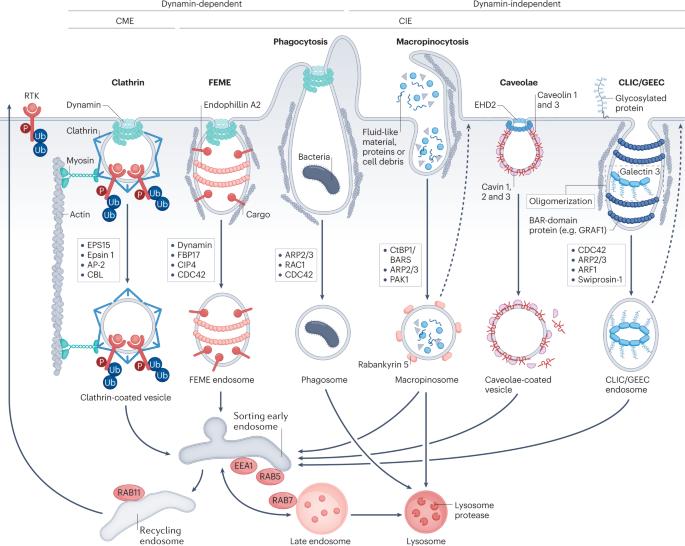Endocytosis in cancer and cancer therapy
IF 72.5
1区 医学
Q1 ONCOLOGY
引用次数: 4
Abstract
Endocytosis is a complex process whereby cell surface proteins, lipids and fluid from the extracellular environment are packaged, sorted and internalized into cells. Endocytosis is also a mechanism of drug internalization into cells. There are multiple routes of endocytosis that determine the fate of molecules, from degradation in the lysosomes to recycling back to the plasma membrane. The overall rates of endocytosis and temporal regulation of molecules transiting through endocytic pathways are also intricately linked with signalling outcomes. This process relies on an array of factors, such as intrinsic amino acid motifs and post-translational modifications. Endocytosis is frequently disrupted in cancer. These disruptions lead to inappropriate retention of receptor tyrosine kinases on the tumour cell membrane, changes in the recycling of oncogenic molecules, defective signalling feedback loops and loss of cell polarity. In the past decade, endocytosis has emerged as a pivotal regulator of nutrient scavenging, response to and regulation of immune surveillance and tumour immune evasion, tumour metastasis and therapeutic drug delivery. This Review summarizes and integrates these advances into the understanding of endocytosis in cancer. The potential to regulate these pathways in the clinic to improve cancer therapy is also discussed. In this Review, Banushi et al. discuss how endocytotic pathways impact many cancer processes including nutrient scavenging, metastasis and therapeutic drug delivery, and how knowledge of these pathways can be used to improve cancer therapy in the clinic.

癌症和癌症治疗中的内吞作用
内吞作用是一个复杂的过程,细胞表面的蛋白质、脂质和细胞外环境中的液体在此过程中被包装、分类并内化到细胞中。内吞也是药物内化进入细胞的一种机制。内吞作用有多种途径,从溶酶体降解到返回质膜再循环,这些途径决定了分子的命运。内吞的总体速率和分子通过内吞途径的时间调节也与信号结果有着错综复杂的联系。这一过程依赖于一系列因素,如固有氨基酸基团和翻译后修饰。癌症患者的内吞功能经常受到破坏。这些干扰会导致肿瘤细胞膜上受体酪氨酸激酶的不适当保留、致癌分子循环的改变、信号反馈回路的缺陷以及细胞极性的丧失。在过去十年中,内吞作用已成为营养物质清除、免疫监视反应和调节、肿瘤免疫逃避、肿瘤转移和治疗药物递送的关键调节因素。本综述总结并整合了癌症内吞作用的这些研究进展。此外,还讨论了在临床中调节这些通路以改善癌症治疗的潜力。在这篇综述中,Banushi 等人讨论了内吞途径如何影响许多癌症过程,包括营养清除、转移和治疗药物递送,以及如何利用这些途径的知识改善临床癌症治疗。
本文章由计算机程序翻译,如有差异,请以英文原文为准。
求助全文
约1分钟内获得全文
求助全文
来源期刊

Nature Reviews Cancer
医学-肿瘤学
CiteScore
111.90
自引率
0.40%
发文量
97
审稿时长
6-12 weeks
期刊介绍:
Nature Reviews Cancer, a part of the Nature Reviews portfolio of journals, aims to be the premier source of reviews and commentaries for the scientific communities it serves. The correct abbreviation for abstracting and indexing purposes is Nat. Rev. Cancer. The international standard serial numbers (ISSN) for Nature Reviews Cancer are 1474-175X (print) and 1474-1768 (online). Unlike other journals, Nature Reviews Cancer does not have an external editorial board. Instead, all editorial decisions are made by a team of full-time professional editors who are PhD-level scientists. The journal publishes Research Highlights, Comments, Reviews, and Perspectives relevant to cancer researchers, ensuring that the articles reach the widest possible audience due to their broad scope.
 求助内容:
求助内容: 应助结果提醒方式:
应助结果提醒方式:


